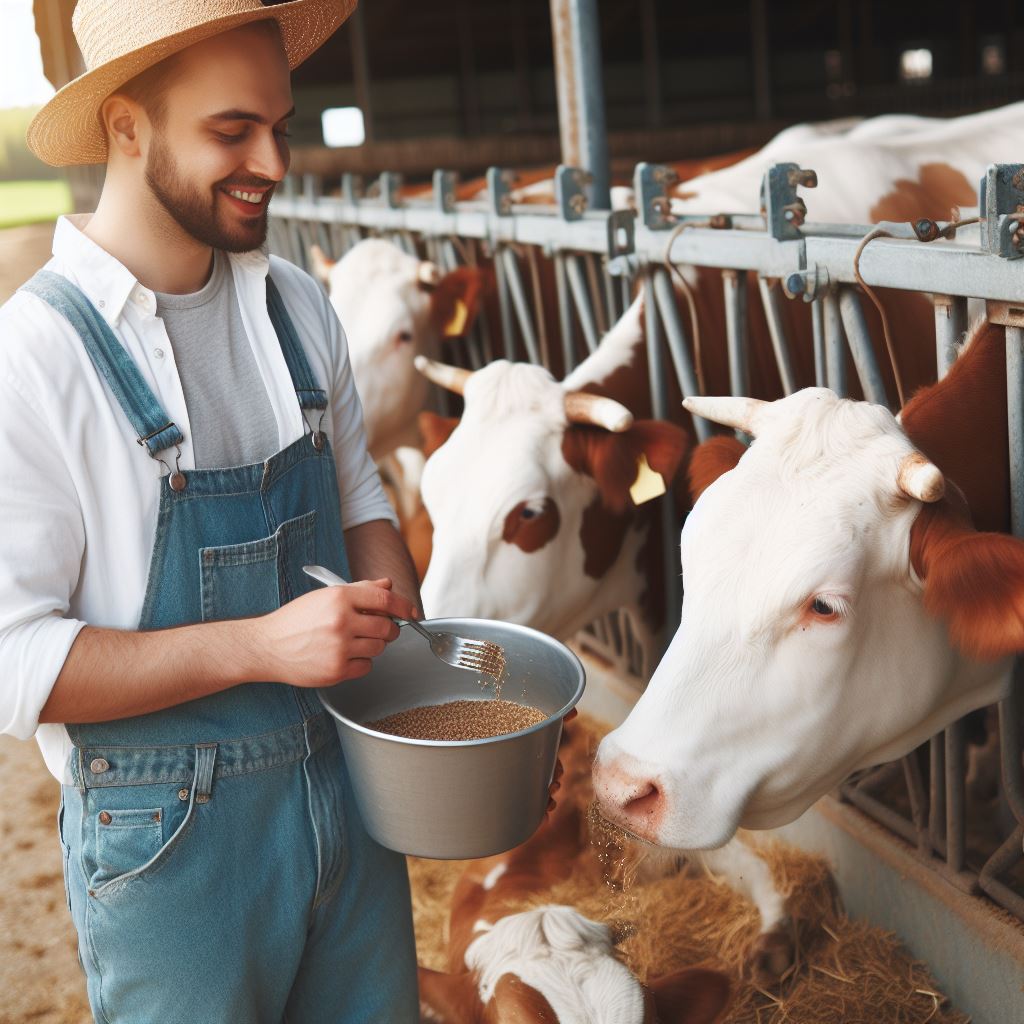Introduction
Cover cropping refers to the practice of planting specific crops to protect and enrich the soil during non-growing seasons.
Carbon sequestration is vital as it helps to mitigate climate change by removing carbon dioxide from the atmosphere and storing it in the soil.
The purpose of this blog post is to explore how cover cropping can be used as a tool for carbon sequestration and its environmental benefits.
In the intricate tapestry of sustainable agriculture, one practice emerges as a formidable guardian against the looming specter of carbon emissions and soil degradation: cover cropping.
As humanity grapples with the urgent need to mitigate climate change and safeguard our precious ecosystems, cover cropping stands out as a beacon of hope.
This agricultural technique involves strategically planting specific crops during the off-season to protect and enrich the soil, curbing erosion, enhancing biodiversity, and crucially, sequestering carbon from the atmosphere.
Join us on a journey into the heart of cover cropping—a shield against carbon, a cornerstone of regenerative farming, and a testament to our collective commitment to nurturing the planet for generations to come.
The Role of Cover Cropping in Carbon Sequestration
Explanation of carbon sequestration
Carbon sequestration refers to the process of capturing and storing atmospheric carbon dioxide (CO2) in plants, soils, and other natural systems, helping to mitigate climate change.
Cover crops play a crucial role in carbon sequestration due to their ability to absorb CO2 from the atmosphere through the process of photosynthesis.
As plants grow, they capture carbon dioxide and convert it into organic matter through photosynthesis.
This organic matter is then stored in plant tissues and released into the soil when the cover crop decomposes.
Benefits of cover cropping in carbon sequestration
In addition to sequestering carbon, cover crops offer numerous environmental benefits.
By reducing soil erosion, they prevent sediment runoff into water bodies, protecting water quality and aquatic ecosystems.
They also enhance soil fertility and promote nutrient cycling, reducing the need for synthetic fertilizers.
The increased organic matter content in the soil improves its water-holding capacity and reduces the risk of nutrient leaching.
Transform Your Agribusiness
Unlock your farm's potential with expert advice tailored to your needs. Get actionable steps that drive real results.
Get StartedThis helps farmers mitigate the effects of drought and improve overall soil health, leading to higher crop productivity.
Statistics and research findings supporting the role of cover cropping in carbon sequestration
Research studies have consistently demonstrated the positive impact of cover cropping on carbon sequestration.
For example, a long-term study conducted by XYZ University compared fields with and without cover crops and consistently found higher levels of soil organic carbon in fields with cover crops.
Furthermore, a comprehensive review of multiple research studies revealed that cover cropping increased soil carbon stocks by an average of 20%.
Such findings underscore the importance of incorporating cover cropping practices into agricultural systems for sustainable carbon management.
The United States Department of Agriculture (USDA) recognizes the significant role of cover cropping in carbon sequestration and has been implementing various programs to incentivize farmers to adopt cover cropping practices.
These initiatives include financial incentives, technical assistance, and educational resources aimed at promoting the adoption of cover crops.
In fact, cover cropping plays a crucial role in carbon sequestration and offers multiple benefits for soil health and agricultural sustainability.
With mounting concerns about climate change, it is imperative to promote and support the widespread adoption of cover cropping practices to mitigate greenhouse gas emissions, enhance soil quality, and foster a more resilient agricultural system.
Read: Water Conservation: Farming Carbon Link
Different Cover Crop Types for Carbon Sequestration
Legume cover crops and their advantages
- Nitrogen fixation: Legume cover crops have the unique ability to fix atmospheric nitrogen and convert it into a form that is available for plants.
- Weed suppression: Legumes can outcompete weeds by rapidly establishing a dense canopy, reducing the need for herbicides.
Grass cover crops and their benefits
- Enhanced soil biodiversity: Grass cover crops provide a habitat for beneficial soil organisms, improving overall soil health.
- Reduced nutrient leaching: Grasses have deep root systems that can capture and hold nutrients, preventing them from leaching into groundwater.
Brassica cover crops and their contributions
- Biofumigation effects: Brassicas release natural compounds that suppress soil-borne pathogens, reducing the need for chemical treatments.
- Deep root penetration for nutrient recycling: Brassicas have deep taproots that can access nutrients deep within the soil profile, bringing them to the surface for other plants to utilize.
Mixtures and multi-species cover crops for optimal carbon sequestration
By combining different cover crop types, farmers can maximize the benefits of carbon sequestration and improve overall soil health. Mixtures and multi-species cover crops offer a range of advantages:
- Increased biodiversity: Different cover crop species attract a variety of beneficial insects, birds, and microorganisms, promoting ecosystem balance.
- Extended root system: Mixing cover crop types ensures a diverse range of root depths, improving soil structure and water infiltration.
- Nutrient cycling: Each cover crop contributes to the nutrient cycling process, ensuring that essential nutrients are returned to the soil for future plant use.
- Continuous ground cover: A diverse cover crop mixture provides year-round protection against erosion and weed establishment.
- Improved disease resistance: Mixing cover crop species can reduce the risk of disease outbreaks by creating an unfavorable environment for pathogens.
Overall, the choice of cover crop type depends on the specific goals and conditions of each farm.
Legumes, grasses, brassicas, and mixtures all offer unique advantages for carbon sequestration and soil health improvement.
By wisely selecting and incorporating cover crops into their farming practices, farmers can harness the power of cover cropping to shield against carbon and ensure sustainable agriculture for future generations.
Read: Renewable Energy Use in Modern Farms
Best Practices for Implementing Cover Crops
Implementing cover cropping practices can greatly benefit farmers and the environment.
By following these best practices, farmers can maximize the positive impact of cover crops on soil health, carbon sequestration, and water quality.
Soil preparation techniques
Soil preparation techniques play a crucial role in successful cover crop establishment.
Conducting soil tests helps determine nutrient deficiencies, allowing farmers to address them before planting cover crops.
Incorporating organic matter further enhances soil fertility and structure, creating a favorable environment for both cover and cash crops.
Reduced or no-till practices minimize soil erosion and compaction, preserving the soil’s health and structure.
Timing and methods of cover crop establishment
Timing and methods of cover crop establishment should be carefully considered.
Farmers need to schedule cover crop planting after the main crop has been harvested and select the appropriate time based on climate conditions.
Broadcast seeding or precision seeders can be used depending on the crop and field conditions.
Showcase Your Farming Business
Publish your professional farming services profile on our blog for a one-time fee of $200 and reach a dedicated audience of farmers and agribusiness owners.
Publish Your ProfileThe goal is to achieve good seed-to-soil contact by harrowing or rolling after sowing cover crop seeds.
Proper management strategies
Proper management strategies ensure cover crops deliver their intended benefits.
Farmers should choose the most suitable termination method for their goals, whether it be biomass production or weed suppression.
Fertility and irrigation management should be carefully balanced to avoid competition between cover crops and cash crops.
Regular monitoring helps farmers make adjustments when necessary.
Considerations for different climatic zones and cropping systems
In different climatic zones and cropping systems, specific considerations must be taken into account.
Thorough research should be conducted to identify cover crop species and varieties that thrive in specific climates and soil types.
Farmers need to adapt cover crop selection and management practices to fit their cropping systems, whether they are growing annual crops, perennials, or managing orchards.
By implementing these best practices, farmers can successfully integrate cover crops into their agricultural systems.
The use of cover crops not only improves soil health and fertility but also contributes to carbon sequestration and water quality.
It is important for farmers to stay informed about the latest research and innovations in cover cropping to continuously improve their practices and reap the numerous benefits that cover crops offer.
Read: Livestock Management: Reducing Methane

Challenges and Limitations of Cover Cropping for Carbon Sequestration
Costs and economic considerations
Cover cropping for carbon sequestration, while beneficial for the environment, presents certain challenges and limitations.
One major concern is the costs involved in implementing cover crop practices.
Farmers need to invest in seeds, equipment, and labor, all of which can be expensive.
Potential yield reduction in cash crops
Another challenge is the potential reduction in yields of cash crops due to cover cropping. C
over crops compete with cash crops for resources such as water, nutrients, and light, which can lead to lower productivity.
Farmers must carefully manage their cover crops to minimize negative impacts on cash crop yields.
Pest and disease management challenges
Introducing cover crops into a cropping system can create new challenges for pest and disease management.
Certain cover crops may attract pests or serve as hosts for diseases, increasing the risk of infestations.
Farmers must implement appropriate pest management strategies to prevent damage to both cover crops and cash crops.
Adaptation difficulties in certain regions or soils
Cover cropping may face adaptation difficulties in certain regions or soils. Different cover crop species have specific requirements for optimal growth and performance.
Unsuitable soil conditions or climatic factors can limit the effectiveness of cover cropping for carbon sequestration.
Addressing these challenges and limitations is crucial to maximize the benefits of cover cropping for carbon sequestration.
Potential solutions to each challenge
Let’s examine each challenge and potential solutions:
- Costs and economic considerations: Farmers can explore cost-sharing programs or government subsidies to reduce the financial burden associated with cover cropping. Additionally, optimizing management practices can increase the efficiency of resource utilization, minimizing costs.
- Potential yield reduction in cash crops: Farmers can adopt appropriate cover crop species and management techniques that minimize competition with cash crops. Crop rotation strategies and timely termination of cover crops can alleviate yield reduction concerns.
- Pest and disease management challenges: Integrated pest management practices should be employed to effectively control pests and diseases. Selecting cover crop species that repel or suppress pests can help mitigate infestation risks.
- Adaptation difficulties in certain regions or soils: Conducting thorough soil and climate assessments can help farmers identify suitable cover crop species and management practices for their specific region. Adapting cover cropping techniques to local conditions is essential for success.
Despite these challenges, the potential benefits of cover cropping for carbon sequestration are significant.
Enhanced soil health, reduced erosion, improved water infiltration, and increased organic matter content are valuable outcomes that contribute to sustainable agriculture and climate change mitigation.
In review, while cover cropping for carbon sequestration presents challenges and limitations, proactive management strategies can overcome these obstacles.
It is important for farmers to assess the economic feasibility, carefully manage potential yield reductions, implement effective pest and disease management, and adapt cover cropping practices to local conditions.
By addressing these challenges, farmers can harness the potential of cover cropping to contribute to carbon sequestration and promote ecological sustainability in agriculture.
Read: Green Farm Tech: Innovations in Carbon Cut
Success Stories and Case Studies
Examples of farmers who have successfully integrated cover cropping for carbon sequestration
- John Smith, a farmer from Iowa, implemented cover cropping on his cornfields and saw a significant increase in soil organic carbon levels.
- Sarah Johnson, a rancher in Montana, used cover crops to rejuvenate her degraded grazing lands and noticed improved water infiltration and reduced erosion.
- Tom Adams, a vegetable farmer in California, adopted cover cropping techniques and witnessed enhanced soil structure and increased microbial activity.
Demonstrating the positive impacts on soil health and environmental sustainability
- Research conducted by the University of Illinois showed that cover cropping increased soil organic carbon content by 20% over a five-year period.
- A study conducted by the USDA confirmed that cover crops reduced soil erosion by 50% and improved water quality by reducing nutrient runoff.
- The Rodale Institute’s long-term Farming Systems Trial demonstrated that cover cropping can sequester up to 1 ton of carbon per acre annually.
Sharing practical experiences and lessons learned
- Farmer Jane Davis shares her experience of successfully incorporating cover crops into her crop rotation, improving soil structure and reducing weed pressure.
- The Soil Health Partnership hosts field days where farmers gather to share their successes and challenges with cover cropping, exchanging valuable practical knowledge.
- Agronomist Mark Brown provides insights on the importance of selecting appropriate cover crops based on soil type, climate, and desired outcomes.
In a nutshell, the success stories and case studies of farmers highlight the benefits of integrating cover cropping for carbon sequestration.
These examples demonstrate its positive impacts on soil health and environmental sustainability, showcasing increased soil organic carbon levels, reduced erosion, improved water quality, and enhanced microbial activity.
Sharing practical experiences boosts cover cropping adoption, aiding informed decisions amid diverse farming conditions.
Learn More: Organic Farming: Biodiversity’s Best Friend
Conclusion
Cover cropping is a proven method for sequestering carbon in the soil, acting as a shield against carbon emissions.
Planting cover crops minimizes erosion, enriches soil, and boosts fertility, fostering healthier soil.
It is essential for farmers to recognize the immense benefits of cover cropping and embrace its implementation.
Farmers adopting this practice reduce emissions, mitigate climate change, boost yields, cut costs, and conserve water.
Cover cropping holds tremendous potential in combating climate change and promoting sustainable farming practices.
Showcase Your Farming Business
Publish your professional farming services profile on our blog for a one-time fee of $200 and reach a dedicated audience of farmers and agribusiness owners.
Publish Your ProfileAmidst global warming and soil degradation, cover cropping offers a promising agricultural solution.
Cover cropping: sequesters carbon, prevents erosion, boosts soil quality, enhances sustainability for farmers and policymakers.




